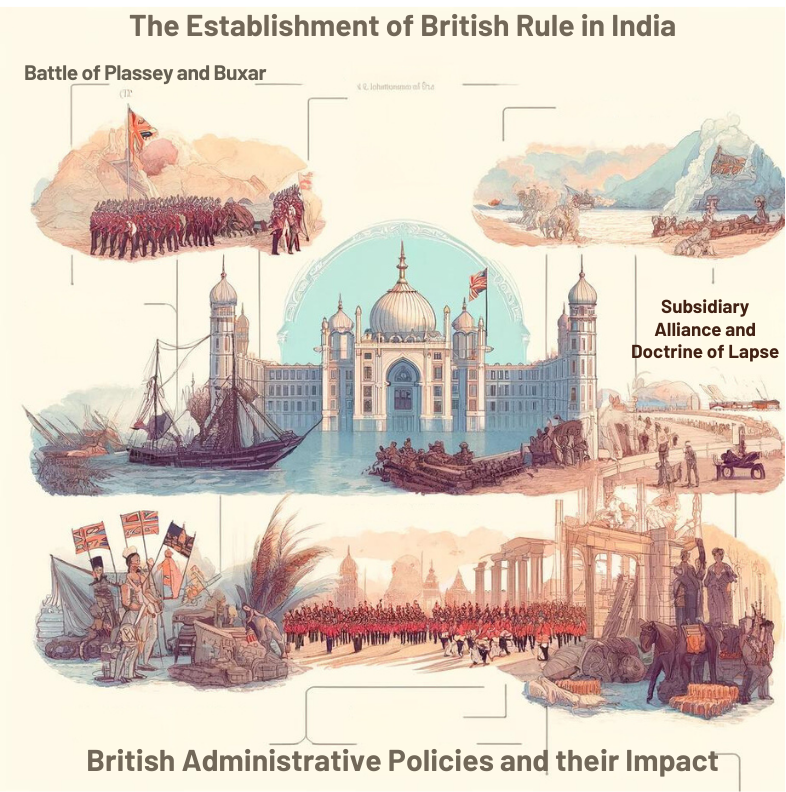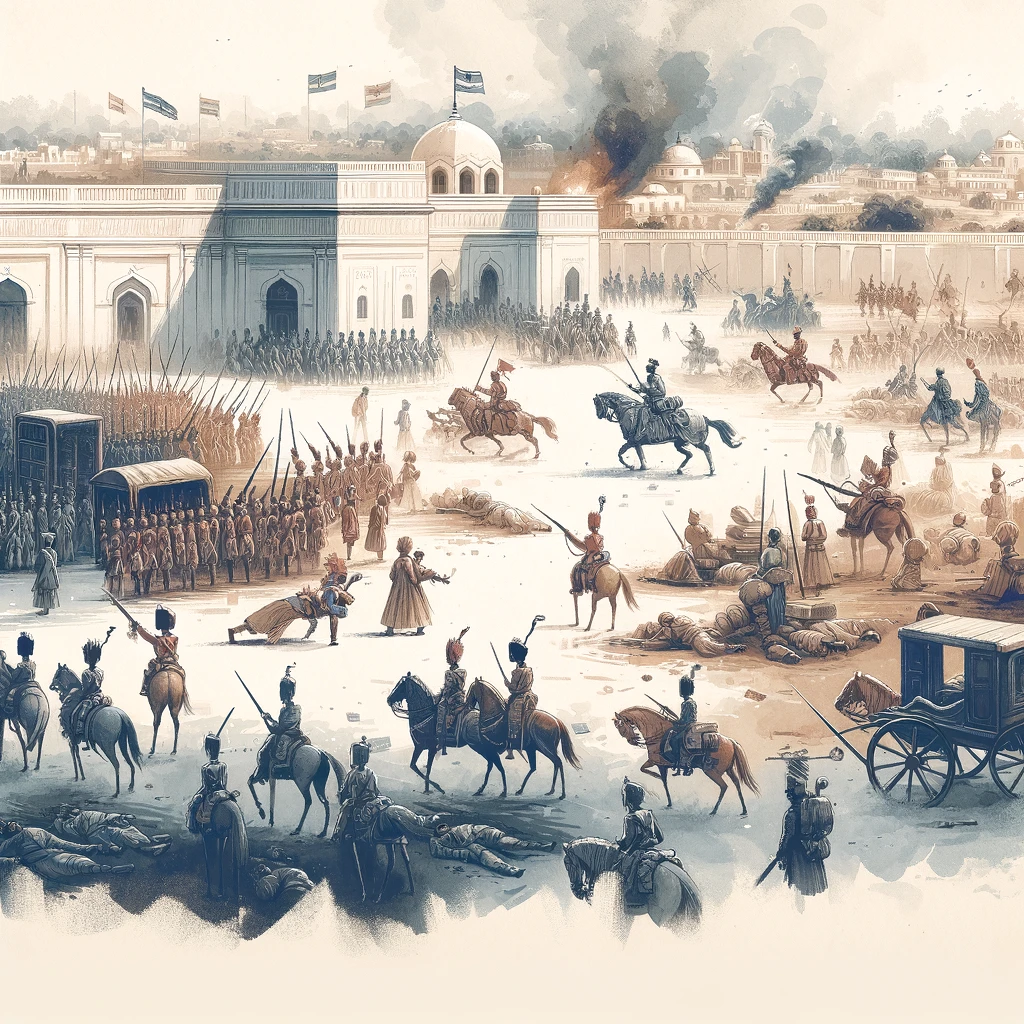The beginning of British rule in India marks a crucial period in the country’s history. Initially arriving as traders, the British East India Company gradually expanded its control through key military victories and strategic alliances. The significant battles of Plassey in 1757 and Buxar in 1764 were turning points that allowed the British to establish their dominance. This era saw the introduction of various policies that changed India’s administration, economy, and society. Through measures like the Subsidiary Alliance and the Doctrine of Lapse, the British strengthened their hold over Indian territories. Thus impacting the lives and governance of the Indian people profoundly.

Battle of Plassey and Buxar
Colonialism was significantly marked by two major battles: the Battle of Plassey (1757) and the Battle of Buxar (1764).
Battle of Plassey (1757): The Battle of Plassey was fought on June 23, 1757, between the British East India Company and the Nawab of Bengal, Siraj-ud-Daulah. The British forces, led by Robert Clive, defeated the Nawab with the help of a conspiracy involving Mir Jafar, who was promised the throne of Bengal. This battle was crucial, as it marked the beginning of British political control in India. The victory at Plassey allowed the British to gain substantial revenue from Bengal, which financed their further expansion.
Battle of Buxar (1764): The Battle of Buxar was fought on October 22, 1764, between the British East India Company and a coalition of Indian rulers including the Nawab of Bengal, Mir Qasim, the Nawab of Awadh, Shuja-ud-Daula, and the Mughal Emperor, Shah Alam II. The British, led by Major Hector Munro, emerged victorious. This battle established British dominance over North India. Moreover, the Treaty of Allahabad (1765) followed, granting the East India Company the Diwani rights (right to collect revenue) of Bengal, Bihar, and Orissa, further consolidating their control.

Subsidiary Alliance and Doctrine of Lapse
The British employed various strategies to expand their control over Indian territories. Two significant policies were the Subsidiary Alliance and the Doctrine of Lapse.
Subsidiary Alliance: Introduced by Lord Wellesley, the Subsidiary Alliance was a treaty between the British East India Company and Indian princely states. Under this system, Indian rulers were required to accept a British resident in their courts, disband their military forces, and instead maintain British troops. In return, the British promised to protect the state from external aggression and internal revolt. This policy effectively reduced Indian states to subsidiary status, depriving them of their sovereignty. States like Hyderabad, Mysore, and Awadh were brought under British control through this alliance.
Doctrine of Lapse: The Doctrine of Lapse was an annexation policy devised by Lord Dalhousie, the Governor-General of India, from 1848 to 1856. According to this doctrine, any princely state or territory under direct British influence without a male heir would automatically be annexed by the British. This policy was aimed at expanding British territories in India. States like Satara, Jhansi, and Nagpur were annexed under this doctrine, causing widespread resentment. Hence, it contributed to the discontent that led to the Revolt of 1857.
Also, read about The Gandhian Era.
British Administrative Policies and Their Impact
The British introduced several administrative policies that had a profound impact on Indian society, economy, and governance.
Revenue Policies
The British implemented various land revenue systems, including the Permanent Settlement (1793), the Ryotwari System, and the Mahalwari System.
- Permanent Settlement: Introduced by Lord Cornwallis in Bengal, it fixed the land revenue that zamindars (landlords) had to pay to the British. This system led to the commercialization of agriculture but also caused hardship to peasants as zamindars exploited them to maximize profits.
- Ryotwari System: Implemented in parts of Madras and Bombay, this system established a direct relationship between the government and the ryots (cultivators), with the revenue assessed on the land held by them.
- Mahalwari System: Introduced in the North-Western Provinces, this system involved revenue settlement with the village community, or mahal. It aimed to increase the government’s revenue share but led to an increased burden on the peasants.
Judicial and Administrative Reforms
The British established a centralized administrative system. They introduced the Indian Civil Service (ICS) to administer their vast empire. The judiciary was reorganized with the establishment of civil and criminal courts. The codification of laws, such as the Indian Penal Code (1860) and the Criminal Procedure Code (1861), aimed to create a uniform legal system.
Economic Policies
British economic policies were designed to serve their own interests. India was transformed into a supplier of raw materials and a market for British-manufactured goods. The traditional Indian industries, particularly the textile industry, suffered due to the influx of cheap British goods. This deindustrialization led to widespread poverty and unemployment.
Educational Policies
The British introduced Western education to create a class of educated Indians who could assist in administration. The English Education Act of 1835, advocated by Lord Macaulay, promoted English as the medium of instruction. The establishment of universities in Calcutta, Bombay, and Madras in 1857 furthered higher education. However, this policy also led to the rise of a nationalist consciousness among educated Indians, eventually contributing to the freedom struggle.
Social Reforms
The British also enacted several social reforms. They abolished practices like Sati (1829) and allowed widow remarriage (1856). These progressive reforms were seen by many Indians as interference in their social and religious practices. Thus, leading to resentment against British rule.
Conclusion
In conclusion, colonialism, or the establishment of British rule in India through military conquests and strategic alliances, had a profound and lasting impact on the country. While it brought administrative and social changes, it also led to economic exploitation and social unrest. Thus, laying the groundwork for India’s struggle for independence.


